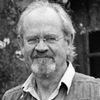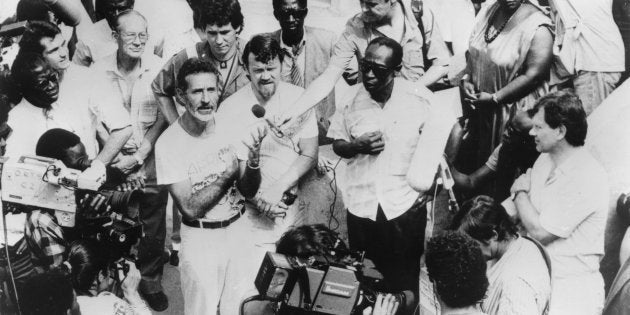
It was a rough and dangerous time, the mid-1980s in South Africa.
A time of states of emergency, detention without trial, apartheid death squads going at full tilt, of almost weekly mass rallies and strikes by the United Democratic Front and Cosatu, bombs going off in public places and troops and violent conflict in the townships.
The African National Congress (ANC) declared 1986 "the Year of Umkhonto we Sizwe", promising to make the country ungovernable. The South African Defence Force (SADF) bombed what they thought were ANC properties in Lusaka, Harare and Gaborone.
On 9 July 1987, a planeful of mostly white, mostly Afrikaans-speaking South Africans landed at Leopold Senghor Airport in Dakar, capital of Senegal. They were warmly welcomed by the very agents of Satan they had been warned against.
President PW Botha was at the height of his "total onslaught" power. The country was effectively run by generals, technocrats and a few ministers through the State Security Council. The ANC, a banned organisation then, was painted as an evil, terrorist and communist force doing imperialist Moscow's dirty work.
The economy was in dire straits, international sanctions and boycotts were biting and the Springboks had only themselves to play with. The Struggle and The System glared at each other with no common ground. There were many whispers of a looming racial or civil war.
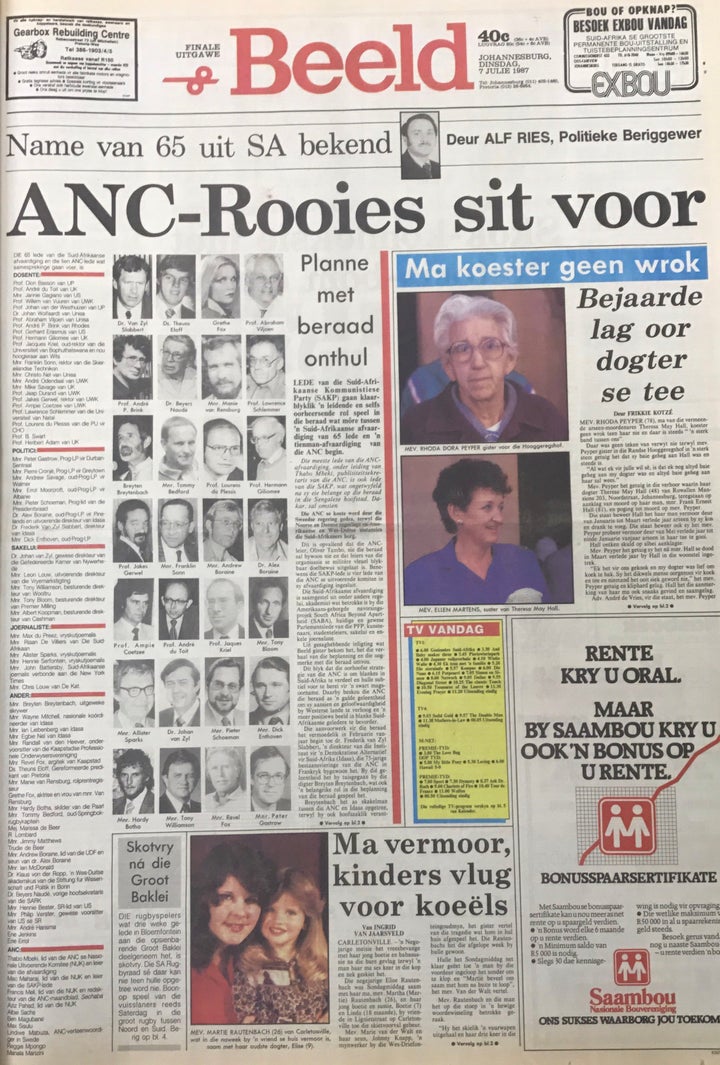
And right in the middle of this, on 9 July 1987, a planeful of mostly white, mostly Afrikaans-speaking South Africans landed at Leopold Senghor Airport in Dakar, capital of Senegal. They were warmly welcomed by the very agents of Satan they had been warned against; people like Thabo Mbeki, Mac Maharaj, Steve Tshwete and Pallo Jordan.
The apartheid government and the ANC in exile knew very well that neither could win the war with weapons. We need to nudge them towards talks.
How did this come about?
It started in 1986 when the charismatic leader of the opposition Progressive Federal Party (PFP) in the white parliament, Frederik Van Zyl Slabbert, announced his shock resignation from parliament, an institution he called irrelevant and not a proper forum for his party to fight against apartheid. He was joined by only one other senior PFP MP, Alex Boraine, and together they launched the Institute for a Democratic Alternative for South Africa (Idasa).
The Dakar Safari was Idasa's first big project and the exiled Afrikaans writer Breyten Breytenbach and friend of Slabbert's was roped in to help. When Slabbert, a friend since my university days, asked me to join the trip, he explained that he was determined to help change the national discourse from confrontation and conflict to that of a peaceful negotiated settlement. Deep down, he told me, the apartheid government and the ANC in exile knew very well that neither could win the war with weapons. We need to nudge them towards talks, he said.
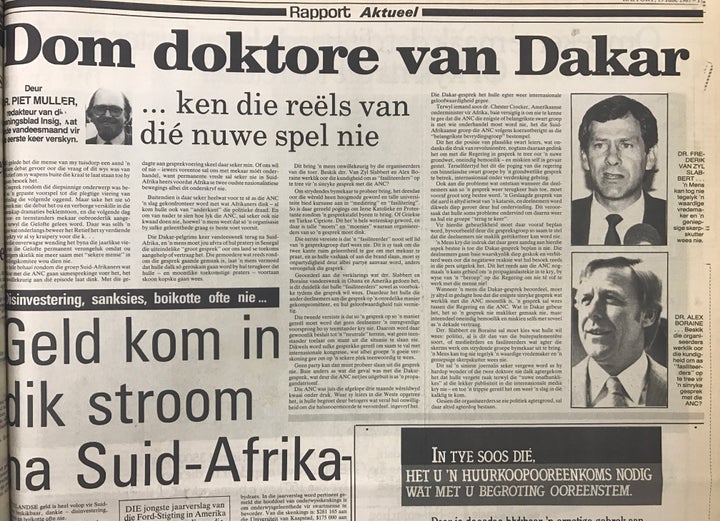
The initiative was supposed to be a big secret until after we left, but the spooks found out soon enough. Why did Niel Barnard, then the powerful boss of National Intelligence, not act and seize all our passports? I don't know. Perhaps they feared the national and international reaction to a step like that against people of the stature of Slabbert and Boraine; perhaps it helped that most of us were Afrikaners; perhaps Barnard had a spy among us and wanted inside information from the meetings.
The substance of the discussions wasn't as important and surprising as was the ease with which the two sides could talk about sensitive matters –- and get to know each other as fellow South Africans.
There were about sixty of us, academics, business people, clergymen, lawyers, a few PFP MP's, writers, artists and others. President Abdou Diouf of Senegal called our group the New Voortrekkers. (Hehehe, yes he did, he was probably given the line by Mbeki. We felt more like "dwarstrekkers".)
Prominent among us were Beyers Naudé, an anti-apartheid stalwart and NG Kerk dominee, and Abraham Viljoen, twin brother of the then head of the SADF, General Constand Viljoen. (I was Business Day's political correspondent at the time and when editor Ken Owen found out about the trip, he asked me to resign.)
The seventeen-strong ANC delegation was led by Thabo Mbeki.
The two parties talked about the armed struggle, the role of the South African Communist Party, the shape of the economy after apartheid, the prospects of national unity and the future of the minority groups. We in the Idasa delegation represented no-one but ourselves, so everyone spoke his/her own mind and there were many disagreements among us. Some focused on the future of the Afrikaans language.
Both sides agreed that racial domination was the source of the violence.
Two events highlighted the need for such meetings. The first was an MK bomb that went off in central Johannesburg while were were talking, the second was the assassination of the youngest member of the ANC's national executive council, Cassius Make, by apartheid agents in Swaziland a day later.
The substance of the discussions wasn't as important and surprising as was the ease with which the two sides could talk about sensitive matters –- and get to know each other as fellow South Africans in the evenings over (many, and I mean many) drinks.
Two opposing groups became one group of South Africans on a trip to meet African leaders.
In a (properly negotiated) joint statement afterwards the two groups declared that while the Idasa group "accepted the historic reality of the armed struggle, athough not all could support it, they were deeply concerned over the proliferation of uncontrolled violence".
Both sides agreed that racial domination was the source of the violence.
And then it said this: "Conference unanimously expressed preference for a negotiated resolution of the South African question. Participants recognised that the attitude of those in power in South Africa is the principle obstacle to progress in this regard."
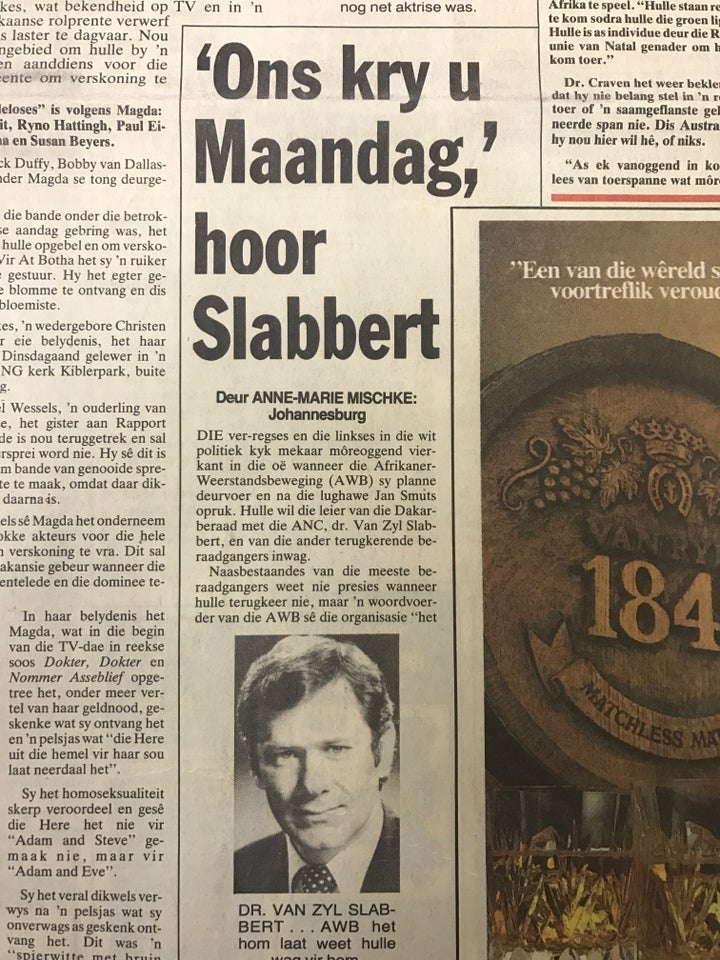
The Idasa group said in a separate statement: "We hope that what began in Dakar will continue inside and outside of South Africa and will eventually involve the South African government itself."
Members of the two groups visited Accra afterwards for a meeting with president Jerry Rawlings and then Ouagadougou for a meeting with the "Ché Guevara of Africa", Burkina Faso president Thomas Sankara. Two opposing groups became one group of South Africans on a trip to meet African leaders.
Thugs from the Afrikaner Weerstandsbeweging (AWB) had taken over the airport and were looking for our blood. It was somehow sobering.
It was in Ouagadougou that we received the first faxes of media reports on the initiative in South Africa (it was thirty years ago -– no email, no internet). We were called useful idiots of the communists and traitors, with the more left-leaning English newspapers preferring to call us "naïve". I was sitting in the garden of our Ouagadougou hotel with Beyers Naudé, Slabbert, Viljoen and Breytenbach when I, the only journalist among them, bemoaned the reactionary attitude of so many of my colleagues. Right there Oom Bey challenged me: "Don't just moan about it, do something about it."
And that was where I decided to launch an anti-apartheid newspaper in Afrikaans, which I did a year later. It was called Vrye Weekblad, a name proposed by Viljoen.
Our mild euphoria after the meetings lasted all the way to what was then still Jan Smuts Airport (now OR Tambo International Airport). When the plane stopped, police stopped us from going through the arrivals hall, instead taking us in small groups to the parking area: thugs from the Afrikaner Weerstandsbeweging (AWB) had taken over the airport and were looking for our blood. It was somehow sobering.
It subverted the hardline ANC's narrative that white South Africans were irredeemable, intransigent racists that couldn't be trusted. It showed that it wouldn't be so hard for Afrikaner nationalists and the ANC to talk and find common ground.
What did it all mean? Did the Dakar Safari have any impact? Opinions differ, but here's mine.
The impact was purely symbolic, but significant. It firmly cemented the desirablity of a peaceful negotiated settlement in the minds of the Botha government and the white public, as well as in the minds of the decision makers in the ANC and UDF. It went a long way to undo the demonisation of both sides. It subverted the "communist, terrorist" narrative Botha and his men had imposed for so long on the white electorate. At the same time, it subverted the hardline ANC's narrative that white South Africans were irredeemable, intransigent racists that couldn't be trusted. It showed that it wouldn't be so hard for Afrikaner nationalists and the ANC to talk and find common ground. It made it plainly clear what the only way out of the impasse was where not one side could achieve a military victory.
The Dakar initiative was followed up with several Idasa-organised meetings between the ANC in exile and business people, writers, students and other groups over the next three years. Talking had become fashionable.
Ten months after Dakar, Botha told Barnard to start a regular dialogue with Nelson Mandela in Pollsmoor prison to figure out what he would do if he were freed and the ANC unbanned. Two years after Dakar, on 5 July 1989, Mandela and Botha had their first face-to-face meeting. Six months after that, senior ANC leaders Govan Mbeki, Walter Sisulu and others were released from prison.
The Idasa group's wish that the Dakar-type talks "will eventually involve the South African government itself" came true.
